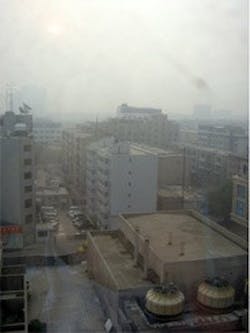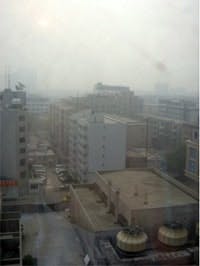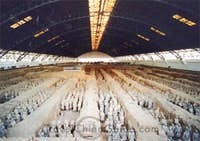I recently returned from a week in China, where I gave a series of speeches on green building in Beijing and Xi’an before the Ministry of Construction and the Xi’an University of Engineering Science and Technology. While these groups are working very hard to undo years of environmental degradation and poor design, talk of “greening” China is, at this point, a faith statement (as in “faith is the evidence of things not seen” … what I experienced my first night in Xi’an).
The hotel will remain nameless to avoid unnecessary correspondence from lawyers, but it was a large facility in central Xi’an. After a long day of travel and talk, I wanted nothing but some rest. Upon checking into my non-smoking room, I detected a slight odor of cigarette smoke but ignored it. The odor got progressively worse as the night wore on, so being unable to sleep, I decided to investigate its source.
The hotel had an open central lobby to the 15 floors above. In the center of the lobby was a cocktail lounge with seating for no less than 700, and most of the patrons were smoking as if a new “no-smoking” ban was going into effect in an hour. So, I had a pretty good idea of the source of the odor – now only to determine how the fumes were getting dispelled into my room on the ninth floor.
It turned out that the smoke was rising up through the open lobby and was being sucked into my room from the return air that was positioned directly above my door. The make-up air was actually the air in the central, inside core of the building – the smoking room (or gas chamber, as I like to refer to it)!
You don’t spend 25 years in the HVAC business without picking up a trick or two, so even though I'm not an engineer, I do like to experiment. My solution was to simply put a towel in front of the door to block the stale air. Then I would crack one or two windows to pull in fresh outside air – problem circumvented.
But not so fast!
That’s when I discovered that the windows were non-operable. And, had I been able to open the windows, I would’ve been exposed to even thicker smog – the result of Xi’an’s power coming from a series of antiquated coal-burning power generation plants.
After a fitful night’s sleep, I awoke to take this picture of the “view” from my hotel room … a sunny day in Xi’an! Don’t adjust your computer monitors – that is the sun in the upper left-hand corner!
The moral of the story (other than “When in Xi’an, bring a supply of oxygen”) is that design is everything. China is committed to change, and I know that the Chinese designers I’ve met with are applying themselves very seriously to achieving a better result. But you can still find poorly designed buildings all over the world, including the United States.
That’s why the U.S. Green Building Council’s Leadership in Energy and Environmental Design (LEED™) certification is such a vitally important standard. I’ve written in the past about the “To LEED or not to LEED” question that we frequently hear in green building discussions. It goes like this: “Isn’t it enough to construct a building that follows green design principles without having to go through the time-consuming and costly effort of certification?” Let me make the point this way: “Isn’t it enough that my 16-year-old son takes and passes Drivers’ Ed without having to go through the nerve-racking process of a road test in order to obtain a driver’s license?”
The obvious answer in both cases is, of course, “No.” The only way to ensure the integrity of a green building that meets high standards; doesn’t cut corners; and provides a healthy, productive indoor environment is through certification. The beauty about LEED certification is that it allows you to say what you do, and do what you say. It’s not just a piece of paper (made from recyclable content, of course) to hang on a wall. So why not see it through to completion?
The history of Xi’an, like most Chinese cities, is rich in tradition and culture. In its 3,100 years of development, 13 dynasties held it as their capital. It is best known as the home of the Museum of Qin Terra Cotta Warriors and Horses – an exhibit of some 7,000 pottery soldiers, horses, chariots, and even weapons that were unearthed by local peasants in the mid-1970s. Covering an area of 16,300 m2, the life-size terra cotta figures of warriors and horses are arranged in battle formations to replicate what the imperial guard looked like in the 3rd century BC. With incredible detail, these figurines were preserved underground for the better part of 2,300 years. Something tells me that, along with their faith in and enthusiasm for green building, the Chinese have an intuitive sense about sustainability.
Rick Fedrizzi is a principal with the Global Environment and Technology Foundation, the Center for Energy and Climate Solutions and president of Green-Think LLC, an environmentally focused marketing and communications consulting firm providing services for the residential and commercial built environments. He also serves as president and CEO of the U.S. Green Building Council, of which he also is founding chairman, and president of the World Green Building Council. Contact by e-mail: ([email protected]).


